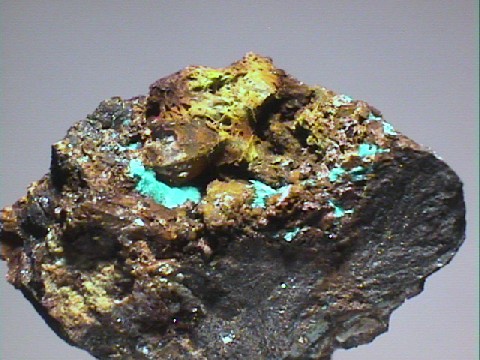 THE
MINERAL CHONDRODITE
THE
MINERAL CHONDRODITE
- Chemistry: ((Mg, Fe)2SiO4)2 - Mg(F, OH)2, Magnesium Iron Silicate Fluoride Hydroxide.
- Class: Silicates
- Subclass: Nesosilicates
- Group: Humite
- Uses: Only as mineral specimens.
Specimens
Chondrodite is the most common and most well known member of the Humite Group of minerals. Members of the Humite Group are noted for having a mixture of silicate layers and oxide layers in their structures. The silicate layers have the same structure as olivine. The oxide layers have the same structure as brucite. In the case of chondrodite, there are two consecutive olivine layers that alternate between each brucite layer. The mineral humite, the next most common member of the group and the group's namesake, has three olivine layers between each brucite layer.
Chondrodite is not a particularly common mineral and is never seen in abundance. It is found in hydrothermal deposits and contact and regionally metamorphosed dolomitic limestones, most notably skarn deposits and in some serpentinite rocks. Crystals when found are very complex with many competing forms adding many different and seemingly unrelated faces. Most often the individual crystals appear rounded or granular. This characteristic of individual grains lead to its name which is derived from a Greek word that means, "grain".
PHYSICAL CHARACTERISTICS:
- Color is commonly yellow, but also brown, reddish brown and red.
- Luster is bright vitreous to resinous.
- Transparency: Crystals are translucent with some unusual specimens being transparent.
- Crystal System: Monoclinic; 2/m
- Crystal Habits include stubby prismatic to tabular or rounded crystals, but as is most commonly the case, as embedded grains. Good crystals show multiple facets without discernible symmetry. Also found massive.
- Cleavage is good in one direction, basal, (not always discernible however).
- Fracture is subconchoidal.
- Hardness is 6 - 6.5
- Specific Gravity is 3.1 - 3.2
- Streak is white.
- Other Characteristics: Twinning may be seen as lamellar striations and some specimens display yellow fluorescence.
- Associated Minerals include
magnetite, diopside, spinel
,
pyrrhotite,
graphite
, humite,
, wollastonite,
monticellite , phlogopite, biotite, serpentine, clinochlore, olivine and calcite. - Notable Occurrences are include Monte Somma, Mount Vesuvius, Italy; Paragas, Finland; Kafveltorp, Sweden; and Franklin, New Jersey; Tilly Foster Mine, Brewster, New York; Riverside County, California and Arizona, USA.
- Best Field Indicators are crystal habit, color, luster, cleavage, environment of formation and hardness.



